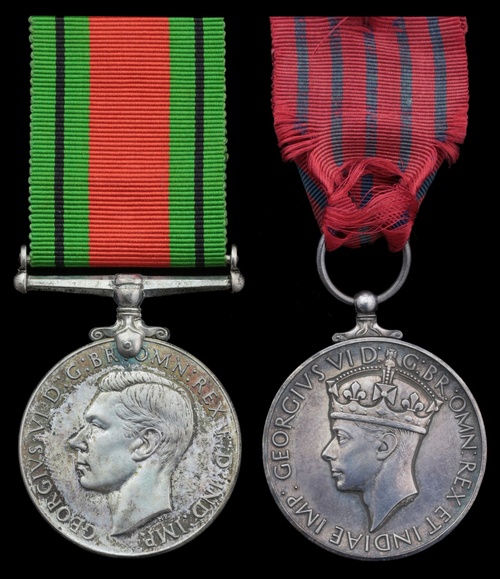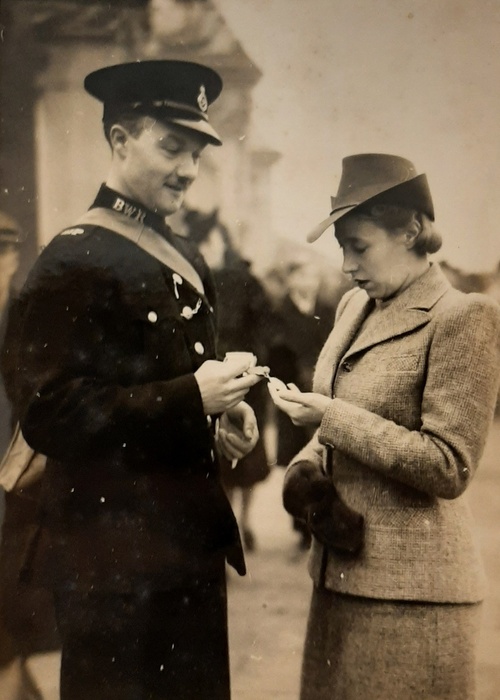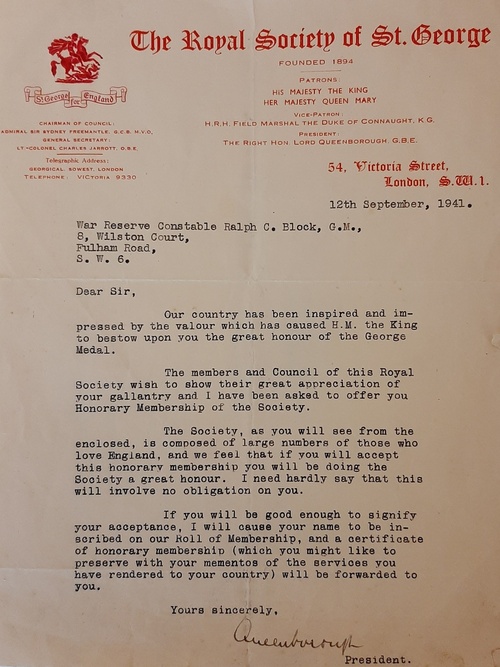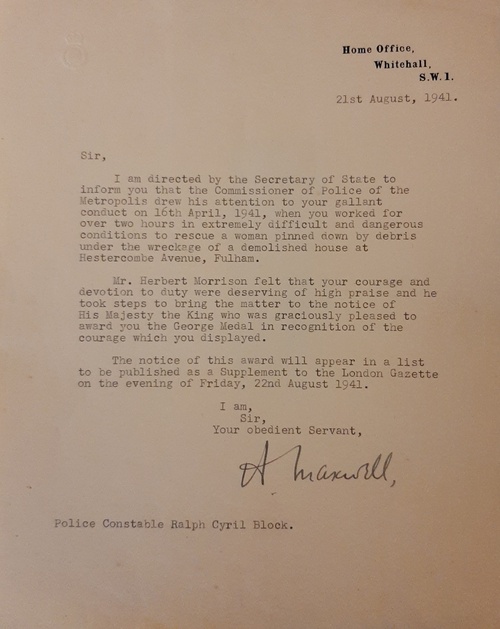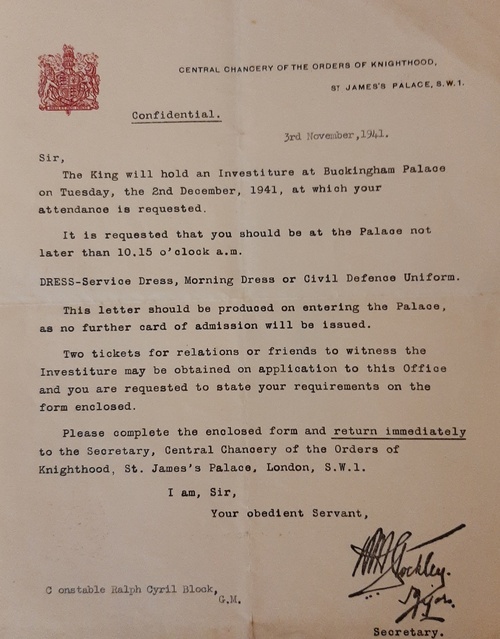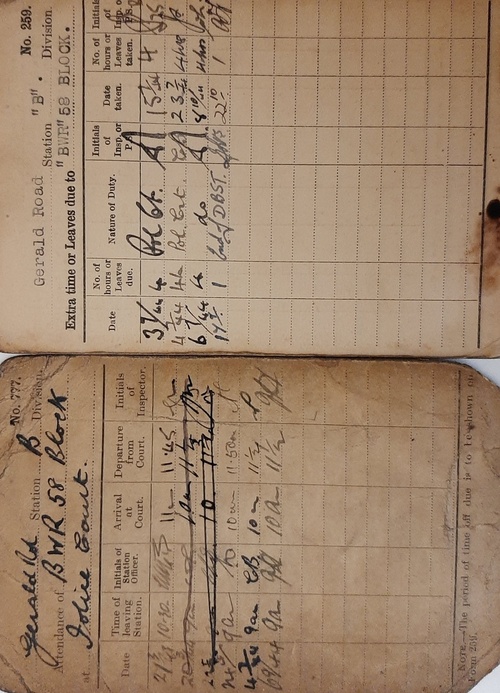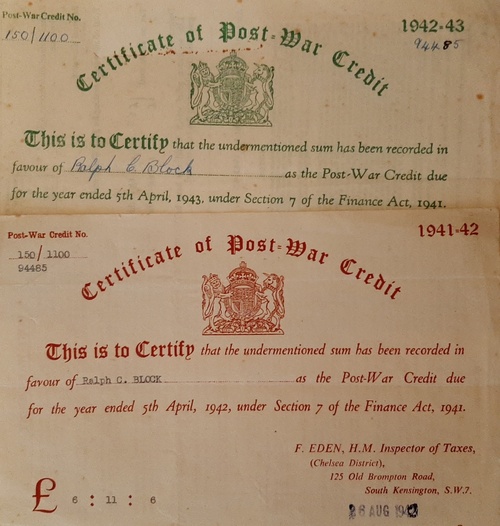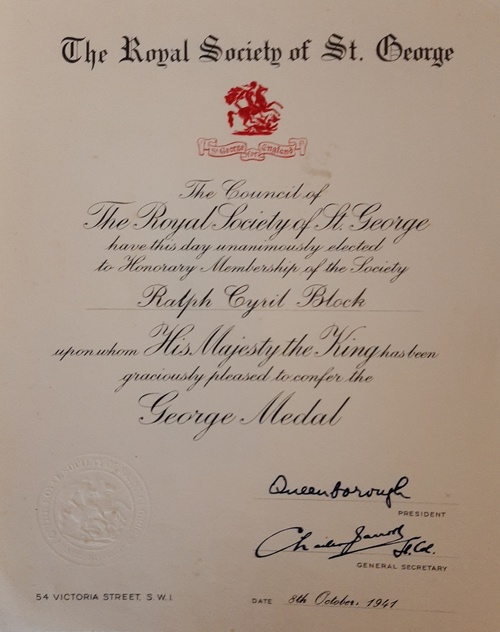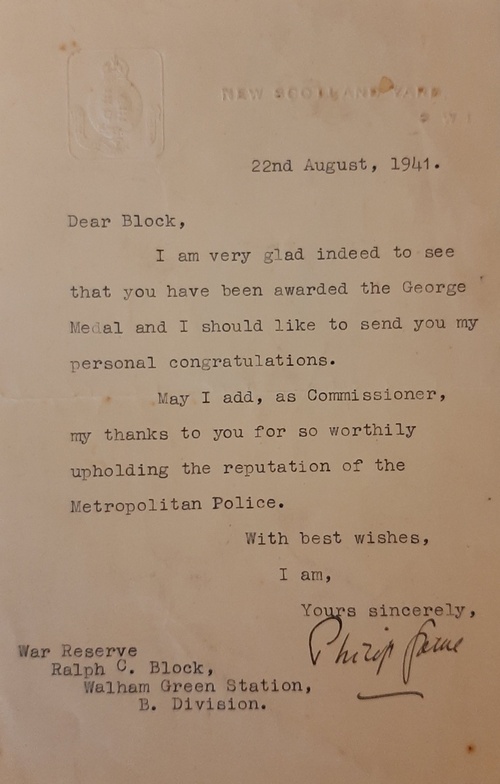Auction: 22103 - Orders, Decorations and Medals VII - e-Auction
Lot: 677
'The woman, pinned by rafters, was located shortly afterwards. The two men cut through the rafter with a saw, and after working for two hours in a confined space they succeeded in rescuing the woman. During the whole time they were in danger from escaping gas, and ammonia fumes were being given off by a damaged refrigerator.
The Fulham Chronicle of 5 December 1941, refers
The '1941 London Blitz' George Medal awarded to War Reserve Constable R. C. Block, 'B' Division, Metropolitan Police
George Medal, G.VI.R. (Ralph Cyril Block), in its card box of issue; Defence Medal 1939-45, minor edge bruise to first, the second somewhat polished, very fine (2)
G.M. London Gazette 19 August 1941, the original citation states:
'Several houses were demolished by bombs and people were trapped.
A faint cry for help was heard and with great difficulty Mr. Prowles, assisted by War Reserve Block, commenced tunnelling towards the spot.
Gradually Prowles and Block disappeared into the tunnel which they shored up as they crawled along. Eventually they reached an injured woman, who was pinned down by rafter. The two men cut through the rafters with a saw, taking care to prevent any collapse of overhead debris.
Gas and water were escaping and ammonia fumes were being given off from a damaged refrigerator.
After two hours' work in a very cramped and confined space the woman was extracted and carried to safety.'
Ralph Cyril Block was born at Southwark in 8 May 1908, the son of George and Mary Block of 18 Chatham Street, Rodney Road, Walworth. When he was seven his elder brother Alfred was killed fighting at Gallipoli. Block worked as an insurance agent until the outbreak of the Second World War when he found employment as a War Reserve Constable for the Metropolitan Police.
On the night of 16-17 April 1941 Block was off-duty at his home on 8 Wilston Court, Fulham Road, when a bomb fell nearby at Hestercombe Avenue. Grabbing his shoes and steel helmet he ran towards the site of the blast where he encountered a number of bystanders who informed him that Mr and Mrs Kentish and Mr Nutting had recently returned home. Entering the property through the garage gates in Durrell Road he joined an impromptu rescue party led by Clerk of Works H. Hutton and A.R.P. Rescue Worker George Prowles.
Block's report of the incident takes up the story:
'I heard a woman's voice faintly calling "Help" from beneath the debris. I saw an aperture in the debris, and with the assistance of Mr. Prowles, whom I believe was a Fulham Rescue Services Worker, commended to remove the debris until we managed to crawl into the hole we had made.'
The testimony of P.C. Edelsten adds detail to this stating 'They had dug a way downwards into the debris and were already shoulder deep. I knelt over the heads of these two men and assisted to support the roof over them. As they dug with their hands, they passed bricks back and I and others assisted to dispose of them.'
Block's narrative continues: 'We had then been working about ¾ hour. Shortly after, we cleared sufficient rubbish to enable us to see the woman (Mrs. Kentish) but we could not free her owing to a number of jammed rafters barring the way. We called for a saw and on receiving one Mr. Prowles and I took turns at propping and sawing the timber. We reached Mrs. Kentish after some time spent at this work, having first found and freed her dog, which was buried to the neck in debris. On reaching the woman we found her to be lying full length on her side pinned in a smashed chair surrounding her timber. We removed the timber and smashed the chair and thus released her.'
Mrs Kentish was much distressed and directed Block and Prowles further into the house to find her father (Mr Nutting) and her husband. Tragically they found her father, dead only a few feet away, he had been crushed under the heavy brickwork of the house. They had at this point been digging for 2 hours and made their way 12 feet into a tangle of unstable bricks and timber facing not only the danger of being crushed but also gassed by the emanations of a damaged refrigerator nearby. Unable to proceed further they withdrew from the tunnel to await further rescue crews; it later transpired that Mr Kentish had also perished under the debris.
He was presented with membership of The Royal Society of St. George in September 1941 and later was decorated by the King at Buckingham Palace on 2 December 1941. Continuing to serve until the end of the war Block died in January 1985 at Marlborough, Wiltshire; sold together with copied research including London Gazette entries, recommendation for award, newspaper articles and details on the deaths of Mr Kentish and Mr Nutting as well as an archive of original research including:
i)
A photograph from the investiture.
ii)
A letter to the recipient from his superior within the Metropolitan Police.
iii)
A letter from The Royal Society of St. George.
iv)
A letter from the Home Office.
v)
A letter from the Central Chancery.
vi)
Several post-war credit's and leave requests.
vii)
An addressed envelope containing a certificate from the Royal Society of St. George.
Subject to 20% VAT on Buyer’s Premium. For more information please view Terms and Conditions for Buyers.
Sold for
£8,000
Starting price
£2100

